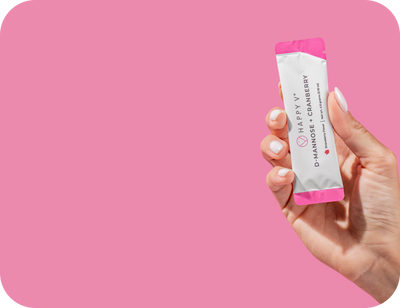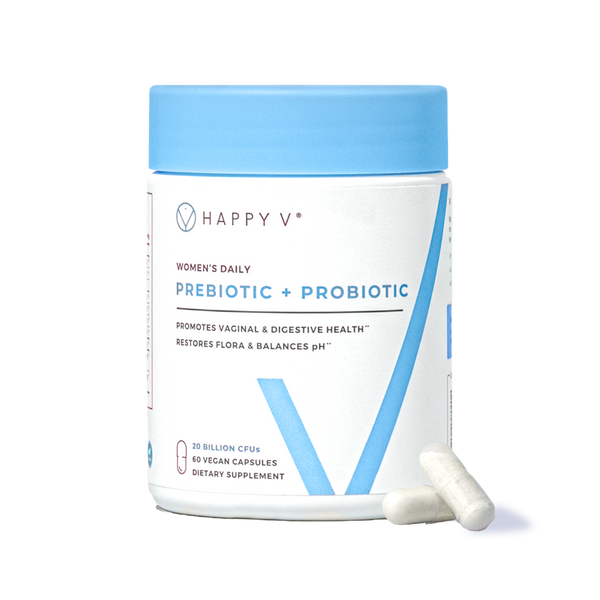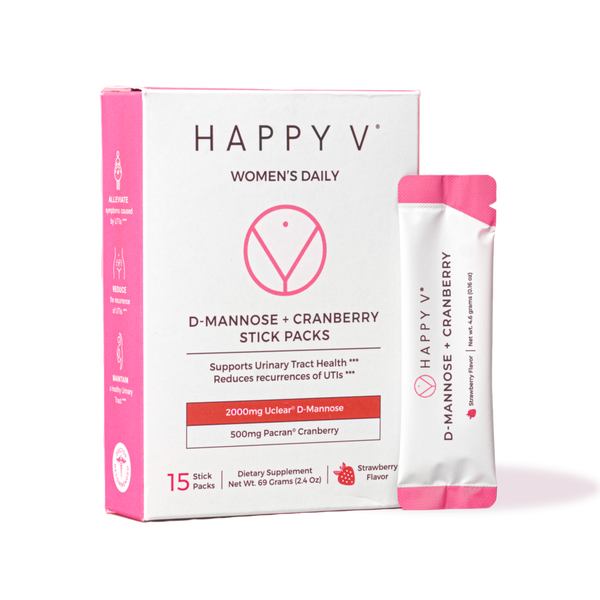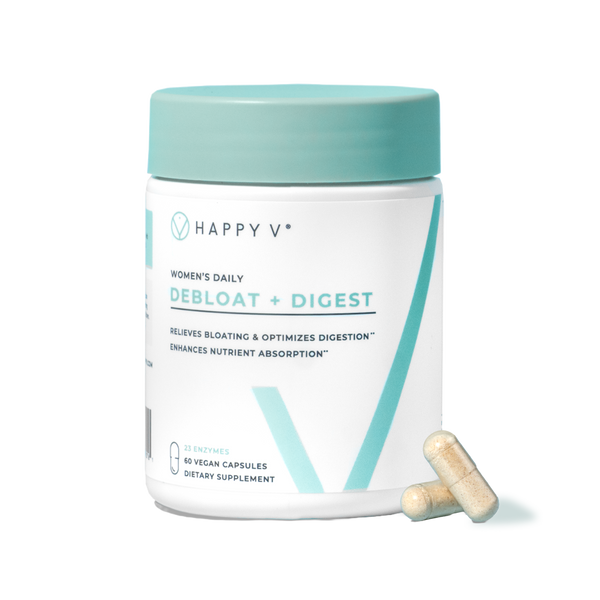- Fact Checked
- August 15, 2025
- 8 min read
Yeast Infection vs. UTI: What’s the Difference?
Table of Contents
Table of Contents
Burning, itching, weird discharge… these are all clear signs you have some kind of vaginal infection1. But what kind is it, exactly?
Yeast infections and UTIs are two of the most common culprits behind vaginal discomfort2. It’s estimated that 1.4 million doctor visits in the United States each year are due to vaginal yeast infections, and that as many as 40% of women between the ages of 20–40 in the United States have had a UTI at least once in their lives.
While these common infections can share some symptoms (hi, painful urination), they’re totally different under the microscope. One is fungal, the other bacterial. One affects the vaginal canal, the other targets the urinary tract.
Knowing which is which can help you avoid using treatments that don’t actually work—or even do more harm than good!— so you feel better faster.
This post is for informational purposes only and does not constitute medical advice. See full disclaimer below.
What Is a Yeast Infection?
A vaginal yeast infection (aka vaginal candidiasis) is a fungal infection caused by an overgrowth of Candida, most commonly Candida albicans3. Normally, Candida lives peacefully in your vaginal microbiome4, but when something throws off your balance (think: antibiotics, fluctuating hormones, or elevated blood sugar), Candida can grow unchecked, disrupting the balance of your microbiome, and causing an infection.
Common Causes of Yeast Infections:
Generally, for yeast infections to occur, something has disrupted the levels of good bacteria in your vaginal flora, allowing Candida to grow and take over5. The most common causes for this disruption are:
- Antibiotic use (which kills off good bacteria like Lactobacillus6)
- Hormonal shifts from pregnancy, menstruation, birth control, or menopause7
- High blood sugar or poorly managed diabetes8
- Wet swimsuits or non-breathable underwear9
- Tight-fitting clothes10
- A weakened immune system (due to illness, stress, or medication)11
What Is a Urinary Tract Infection (UTI)?
A UTI is a bacterial infection in the urinary system. The urinary system includes the urethra, bladder, ureters, and kidneys, but most infections occur in the lower tract (aka urethra and bladder). The most common cause is E. coli, a bacteria that typically comes from the GI tract.
While both men and women can get UTIs, they are far more common in women due to anatomy; the urethra in women is shorter, so UTI-causing bacteria have a shorter distance to travel to reach and infect the bladder.
Risk Factors for UTIs:
These lifestyle factors put you most at risk for a UTI because they increase the likelihood of E. coli exposure and/or bacteria build-up in the urinary tract:
- Wiping from back to front12
- Having sex without urinating before or after13
- Use of diaphragms or spermicides14
- Holding in urine for long periods
- Catheter use15
- Menopause or anatomical changes
- Chronic health conditions like diabetes or immune suppression16
Yeast Infection vs. UTI Symptoms
While certain symptoms of these infections, like burning during urination, overlap, there are distinct differences in how each presents that give you a clue as to what you’re dealing with.
Yeast Infection Symptoms:
The most common symptoms of a yeast infection include:
- Thick, white, “cottage cheese”-like vaginal discharge (typically odorless)17
- Vaginal or vulvar itching and soreness18
- Swelling and redness around the genital area19
- Pain during sex or urination20
- Rash or bumps on the vulva, near the vaginal opening
UTI Symptoms:
The most common symptoms of a urinary tract infection include:
- A burning sensation when urinating21
- Frequent urge to urinate, even if only a little comes out
- Swelling or redness of the vulva
- Cloudy, foul-smelling, or reddish (bloody) urine
- Pressure or pain in the lower abdomen or near the pubic bone
- Feeling like you haven’t fully emptied your bladder
- Fever, chills, or nausea (if the infection travels to the kidneys)
Even if you feel 100% positive you know which infection you’re dealing with, it’s still best to see a doctor to confirm diagnosis before beginning treatment. Self-misdiagnosis when it comes to vaginal infections is incredibly common, and it’s possible to have multiple vaginal infections at once. Your doctor will pinpoint the exact cause of your symptoms so you can start the most effective treatment.
How Are They Diagnosed?
Because vaginal yeast infections and urinary tract infections affect different parts of the body, each requires a different test. Luckily, both are quick and relatively painless!
- Yeast infections are usually diagnosed with a vaginal swab, which checks for Candida overgrowth under a microscope.
-
UTIs are diagnosed through a urine sample that’s tested for bacteria, white blood cells, and other signs of infection.
If you’re experiencing recurring infections, your doctor may suggest further testing to rule out underlying causes or anatomical abnormalities.
Treatment Options
Correctly diagnosing your symptoms is critical because, as you’ll see, getting rid of yeast infections and UTIs involves two very different forms of treatment.
For Yeast Infections:
The most common treatments for yeast infections include:
- Over-the-counter antifungal treatments, like miconazole or clotrimazole creams, suppositories, or tablets22
- Prescription antifungals, such as fluconazole (oral)23
- Probiotics with clinically proven strains of Lactobacillus acidophilus and L. rhamnosus to restore healthy vaginal flora and reduce future flare-ups.
For UTIs:
For UTIs, the most common treatment plan includes:
- Prescription antibiotics, typically for 3–7 days
- Pain relief with over-the-counter medications
- Hydration, to help flush bacteria from the urinary system
Remember: UTIs cannot be treated with antifungals, and yeast infections don’t respond to antibiotics. See your doctor to know what you’re dealing with.
How to Prevent Yeast Infections and UTIs
As common as both yeast infections and UTIs are, they are also highly preventable through simple lifestyle changes.
Yeast Infection Prevention:
Preventing yeast infections is often a matter of increasing your overall vaginal health. To do this:
- Avoid douches, scented sprays, and other harsh products that can disrupt your vaginal pH
- Choose breathable cotton underwear
- Change out of wet or sweaty clothing quickly after swimming or exercising
-
Balance your vaginal microbiome with probiotics, especially after antibiotics or during hormonal changes (like menstruation or menopause)
UTI Prevention:
Seven million women develop UTIs every year in the U.S., with as many as 44% of those experiencing a recurrence within 6 months. You can prevent being part of that 44% by making sure you:
- Wipe front to back
- Pee before and after sex
- Stay hydrated
- Don’t hold in urine
- Use mild, unscented soap around the genital area
When to See a Healthcare Provider
If symptoms persist beyond a few days, worsen, or keep coming back, it’s time to talk to your healthcare provider. You should also get medical advice if:
- It’s your first yeast infection or UTI
- You’re pregnant or have a chronic health condition like diabetes
- You’ve had four or more yeast infections in a year (this may indicate recurrent yeast infections)
- You develop fever, chills, nausea, or vomiting, which can be a sign your UTI has spread to your kidneys
And while we’ve mentioned that symptoms of yeast infections and UTIs can mimic each other, they can also mimic other vaginal infections or even sexually transmitted infections (STIs). So never make a guess, no matter how educated. Get a formal diagnosis for any vaginal symptoms.
How Happy V Can Help
Recurring yeast infections or UTIs can feel like a never-ending cycle, but Happy V offers real support from the inside out.
Our doctor-formulated Prebiotic + Probiotic contains clinically studied strains of Lactobacillus, including L. acidophilus and L. rhamnosus, to help restore vaginal pH, rebalance the microbiome, and reduce Candida overgrowth. Whether you’re recovering from antibiotics, navigating hormonal shifts, or simply looking to prevent future infections, adding a daily probiotic can be a powerful part of your wellness routine.
For urinary tract health, our D-Mannose + Cranberry supplement is a smart, science-backed way to support your bladder. D-Mannose is a naturally occurring sugar that helps flush E. coli from the urinary tract before it can stick. Combined with cranberry extract, which has been shown to support a healthy urinary environment, this duo works to protect your body where it matters most.
While Happy V’s supplements are formulated with high-quality ingredients and without unnecessary fillers, it’s important to consult your healthcare provider before starting any new supplement, especially if you have an active infection or underlying medical condition. These products are intended to support overall vaginal and urinary health but are not a substitute for antibiotics or antifungal medications. Use them as part of a proactive wellness routine to help maintain balance and support your body’s natural defenses.
Final Thoughts
Yeast infections and UTIs are incredibly common, but they’re not the same thing. Understanding the difference helps you get relief sooner and avoid making things worse with the wrong treatment.
Your body gives you signs. Listen to them. Trust your gut (and your vagina). And support your health with care that works—naturally.
Keep the Conversation Going
- Visit our blog for more women’s health tips.
- Join our private Happy V Facebook group to hear from others who’ve been there.
- Explore supplements designed to support your vaginal health journey.
Disclaimer: This blog is for informational and educational purposes only and is not intended to diagnose, treat, cure, or prevent any disease. Statements about supplements have not been evaluated by the Food and Drug Administration. For more information about vaginal infections, visit the CDC or speak to a licensed healthcare provider.








